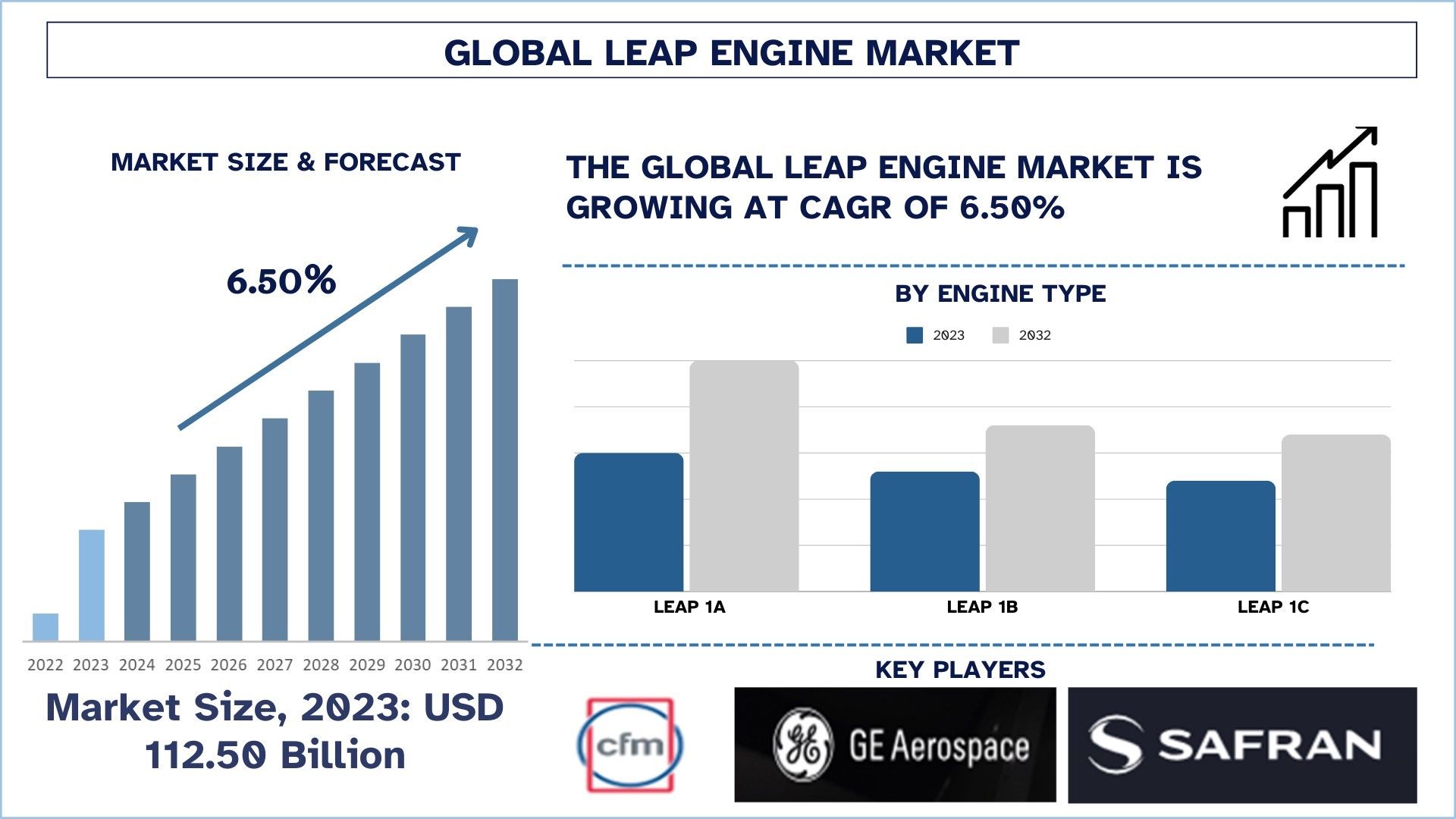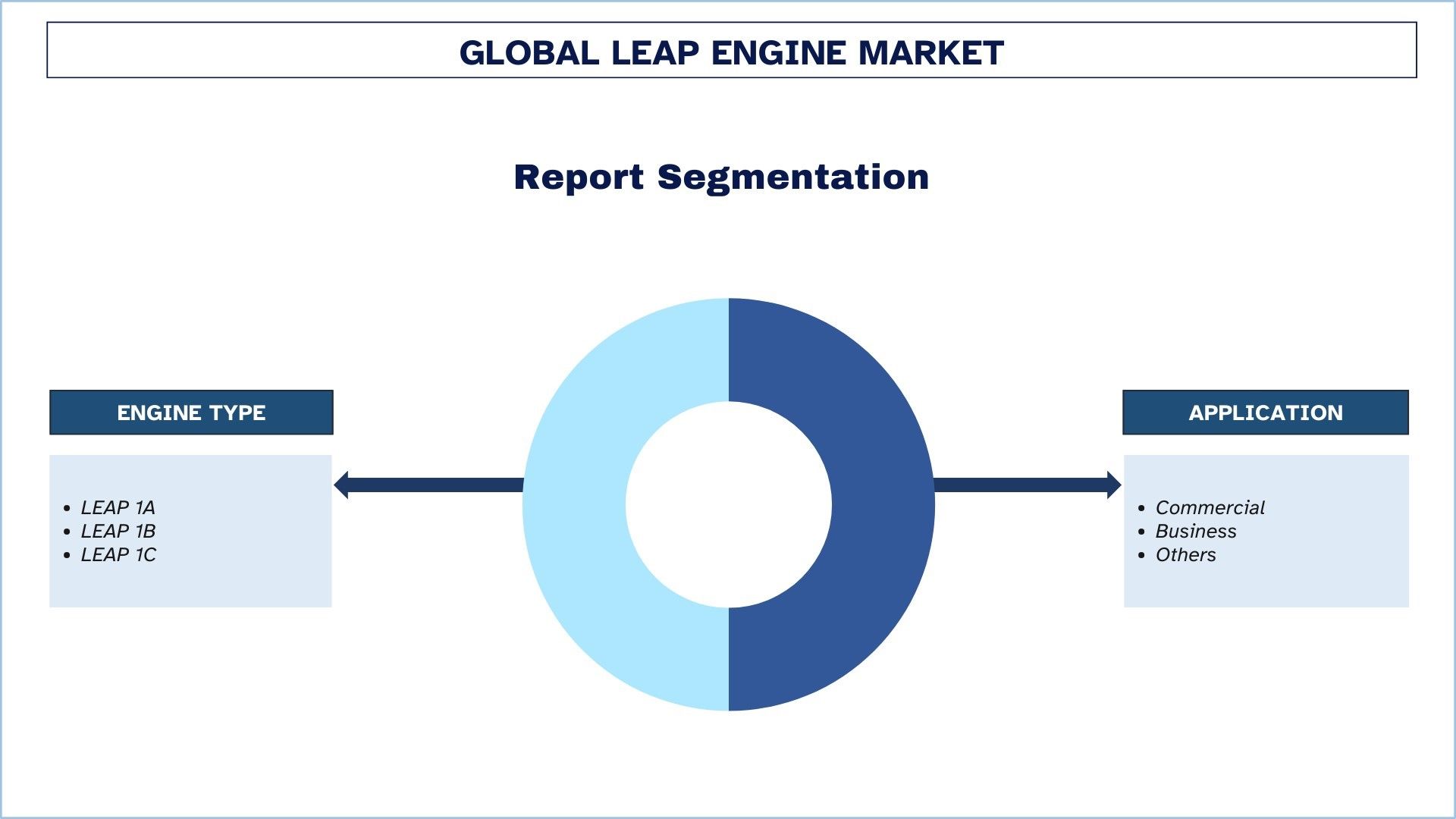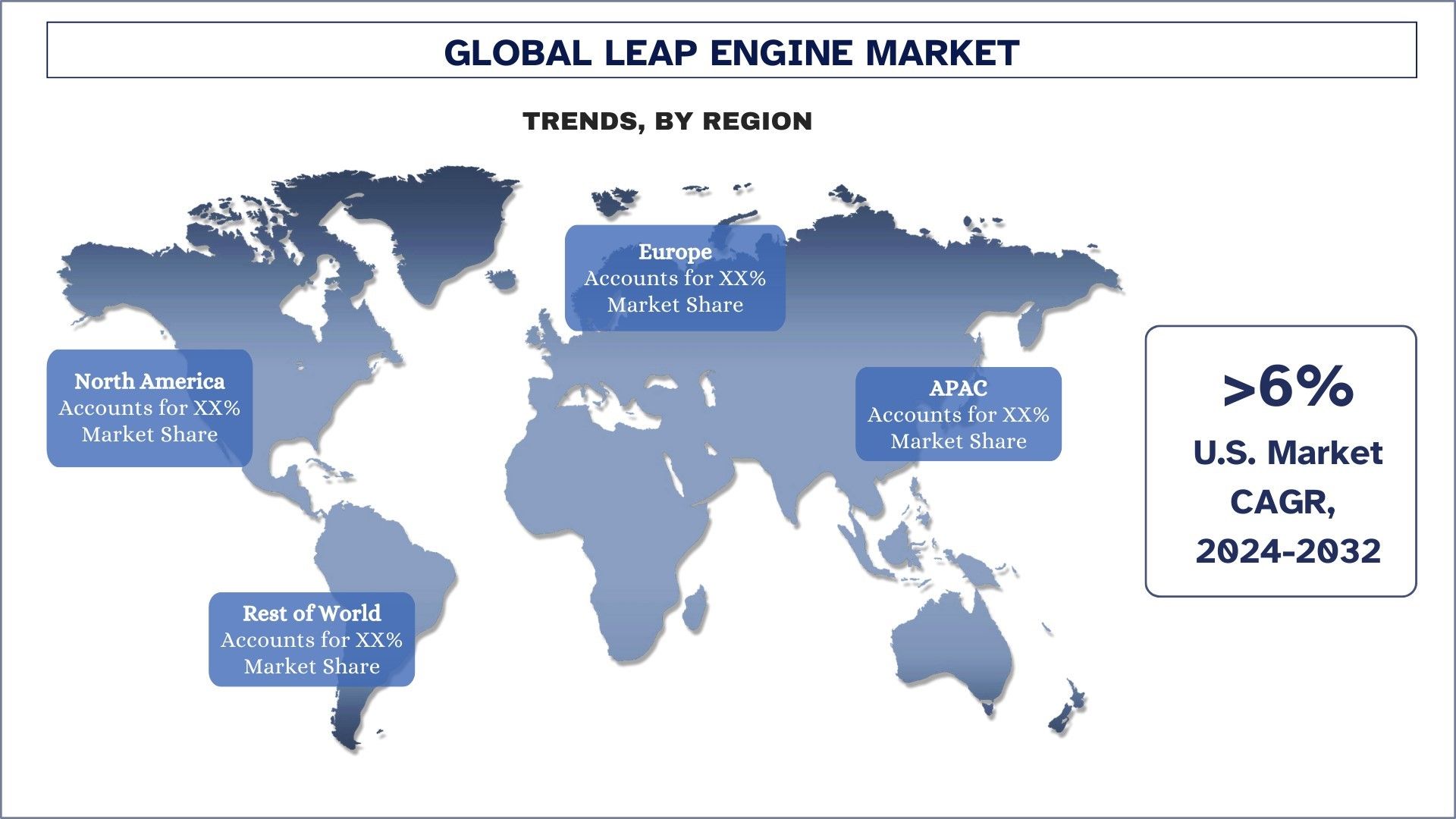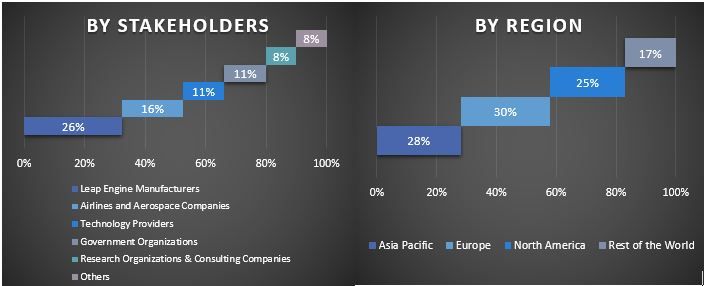- Trang chủ
- Về chúng tôi
- Ngành
- Dịch vụ
- Đọc
- Liên hệ với chúng tôi
Thị trường Động cơ Leap: Phân tích và Dự báo Hiện tại (2024-2032)
Nhấn mạnh vào Loại Động cơ (LEAP 1A, LEAP 1B và LEAP 1C); Ứng dụng (Thương mại, Doanh nghiệp và Khác); và Khu vực/Quốc gia

Quy mô & Dự báo Thị trường Động cơ Leap
Quy mô thị trường động cơ leap được định giá xấp xỉ 112,50 tỷ USD vào năm 2023 và dự kiến sẽ tăng trưởng với CAGR đáng kể khoảng 6,50% trong giai đoạn dự báo (2024-2032) do sự gia tăng của du lịch hàng không, nhu cầu về động cơ đáng tin cậy và tiết kiệm nhiên liệu hơn cũng như các quy định về môi trường ngày càng tăng.
Phân tích Thị trường Động cơ Leap
Động cơ Leap mang lại hiệu quả sử dụng nhiên liệu cao hơn so với các động cơ thế hệ trước. Động cơ leap đã duy trì hiệu quả sử dụng nhiên liệu được cải thiện từ 15% đến 20% cho đến nay, đây là một yếu tố chính thu hút các hãng hàng không. Các công ty hàng không lớn trên thế giới đang hiện đại hóa đội bay của họ và áp dụng động cơ leap để giảm chi phí vận hành và tăng cường sự hiện diện trên thị trường. Ví dụ: vào tháng 7 năm 2024, Macquarie AirFinance đã hoàn tất thỏa thuận cho 20 máy bay Boeing 737 MAX được trang bị 40 động cơ LEAP-1B. Công ty quản lý đội bay hơn 160 máy bay do CFM cung cấp đang hoạt động hiện nay, bao gồm cả máy bay Boeing 737NG và Airbus A320ceo family được trang bị CFM56 và máy bay 737 MAX 8 và A320neo được trang bị LEAP. Ngoài ra, các quy định về môi trường ngày càng tăng để giảm lượng khí thải CO2 đã thúc đẩy nhu cầu về động cơ leap. Theo báo cáo do CFM International công bố, có hơn 3300 động cơ leap đang hoạt động, giúp tiết kiệm lượng khí thải CO2 hơn 35 triệu tấn. Động cơ này là một trong những sản phẩm tiên tiến và mạnh mẽ nhất trong lịch sử 50 năm của CFM International. Do đó, với việc các hãng hàng không áp dụng động cơ này ngày càng nhiều, thị trường được thiết lập để trải qua sự tăng trưởng đáng kể trong giai đoạn dự báo.
Những Phát triển Gần đây trên Thị trường:
Vào tháng 4 năm 2024, CFM International đã phát triển và cung cấp động cơ LEAP-1A được trang bị hệ thống xả ngược (RBS) mới của mình cho Airbus. Động cơ LEAP-1A với hệ thống RBS mới, giúp giảm thiểu sự tích tụ carbon trên vòi phun nhiên liệu, đã được FAA và EASA chứng nhận vào năm 2023. Do đó, yêu cầu thay thế vòi phun nhiên liệu trên cánh và gánh nặng bảo trì liên quan sẽ giảm đáng kể.
Vào tháng 3 năm 2024, American Airlines, một trong những hãng hàng không lớn nhất thế giới, đã hoàn tất nhiều thỏa thuận với CFM International về động cơ LEAP-1B để cung cấp năng lượng cho đội bay Boeing 737 MAX 8 và MAX 10 của hãng. Thỏa thuận bao gồm việc mua các động cơ dự phòng, bao gồm một thỏa thuận dịch vụ 20 năm mới bao gồm các động cơ LEAP-1B hiện có và mới của America.
Xu hướng Thị trường Động cơ Leap
Bảo trì Dự đoán dựa trên AI
Một trong những xu hướng lớn nổi lên trên thị trường động cơ leap là nhu cầu ngày càng tăng đối với bảo trì dự đoán dựa trên AI. Trong thế giới ngày nay, AI đã trở nên tối quan trọng đối với các ngành công nghiệp khác nhau, bao gồm hàng không vũ trụ và quốc phòng, giúp cải thiện hiệu suất động cơ, giảm thời gian ngừng hoạt động và tăng tuổi thọ của động cơ leap. Ví dụ: vào tháng 2 năm 2024, Lufthansa Systems đã giới thiệu trợ lý kiểm soát hoạt động hỗ trợ AI tiên tiến mới cho ngành hàng không. NetLine/Ops ++ aiOCC là một trợ lý AI dựa trên web, hỗ trợ các bộ điều khiển hoạt động của hãng hàng không trong việc tăng cường sự ổn định và hiệu quả của các hoạt động hàng ngày. Giải pháp này đã được sử dụng và tối ưu hóa chung với những khách hàng đầu tiên. Ngoài ra, các công ty hoạt động trên thị trường đang đầu tư những khoản tiền lớn để nâng cấp bảo trì dự đoán. Ví dụ, vào năm 2024, GE đang tích hợp AI vào bảo trì phòng ngừa cho động cơ phản lực, nhằm mục đích cắt giảm một phần ba số lần tháo gỡ không theo lịch trình. Được phát triển tại trung tâm Bengaluru của GE, hệ thống “Digital Twin” dựa trên AI sử dụng phân tích hình ảnh để dự đoán các lỗi và ưu tiên bảo trì. Do đó, bảo trì dự đoán dựa trên AI đang định hình lại thị trường động cơ leap.

Bắc Mỹ dự kiến sẽ thống trị thị trường trong giai đoạn dự báo
Bắc Mỹ nắm giữ phần lớn thị phần vào năm 2023. Các yếu tố chính góp phần vào sự tăng trưởng của thị trường bao gồm sự hiện diện mạnh mẽ của các hãng hàng không lớn, những hãng này liên tục hiện đại hóa đội bay của mình. Ngoài ra, Boeing, một trong những công ty hàng không vũ trụ lớn, có trụ sở chính tại Hoa Kỳ, đã chiếm một thị phần đáng kể trong khu vực, điều này đã thúc đẩy thị trường. Boeing đã nhận được cam kết cho khoảng 600 máy bay bổ sung, tổng cộng là 1.400 động cơ. Hơn nữa, một số yếu tố chung thúc đẩy nhu cầu cho thị trường bao gồm thu nhập khả dụng ngày càng tăng, sự tăng trưởng của các hãng hàng không giá rẻ và các quy định về môi trường ngày càng tăng. Ví dụ: vào tháng 7 năm 2024, Nordic Aviation Capital (NAC), một công ty hàng đầu toàn cầu trong lĩnh vực cho thuê máy bay, hôm nay đã công bố đơn đặt hàng mười động cơ LEAP-1A để cung cấp năng lượng cho năm máy bay thuộc dòng Airbus A321neo. Thỏa thuận này cũng bao gồm các tùy chọn cho hai máy bay dòng A321neo bổ sung được trang bị LEAP. Như vậy, trong số các khu vực, Bắc Mỹ nắm giữ một thị phần đáng kể trên thị trường vào năm 2023.

Tổng quan về Ngành Động cơ Leap
Thị trường động cơ leap có tính cạnh tranh, với một số công ty tham gia thị trường toàn cầu và quốc tế. Các công ty chủ chốt đang áp dụng các chiến lược tăng trưởng khác nhau để tăng cường sự hiện diện trên thị trường của họ, chẳng hạn như quan hệ đối tác, thỏa thuận, hợp tác, mở rộng địa lý và sáp nhập và mua lại. Một số công ty lớn hoạt động trên thị trường là CFM International, General Electric Company và Safran S.A.
Phạm vi Báo cáo Thị trường Động cơ Leap
Thuộc tính Báo cáo | Chi tiết |
Năm cơ sở | 2023 |
Giai đoạn dự báo | 2024-2032 |
Động lực tăng trưởng | Tăng tốc với CAGR là 6,50% |
Quy mô thị trường năm 2023 | 112,50 tỷ USD |
Phân tích khu vực | Bắc Mỹ, Châu Âu, APAC, Phần còn lại của Thế giới |
Khu vực đóng góp chính | Bắc Mỹ dự kiến sẽ thống trị thị trường trong giai đoạn dự báo. |
Các quốc gia chính được đề cập | Hoa Kỳ, Canada, Đức, Vương quốc Anh, Tây Ban Nha, Ý, Pháp, Trung Quốc, Nhật Bản và Ấn Độ |
Các công ty được giới thiệu | CFM International, General Electric Company và Safran S.A. |
Phạm vi Báo cáo | Xu hướng Thị trường, Động lực và Hạn chế; Ước tính và Dự báo Doanh thu; Phân tích Phân khúc; Phân tích Cung và Cầu; Bối cảnh Cạnh tranh; Hồ sơ Công ty |
Các Phân khúc được Đề cập | Theo Loại Động cơ; Theo Ứng dụng; Theo Khu vực/Quốc gia |
Lý do nên mua báo cáo này:
Nghiên cứu bao gồm phân tích quy mô thị trường và dự báo được xác thực bởi các chuyên gia ngành công nghiệp chủ chốt đã được xác thực.
Báo cáo trình bày một đánh giá nhanh về hiệu quả hoạt động tổng thể của ngành trong nháy mắt.
Báo cáo bao gồm phân tích chuyên sâu về các đồng nghiệp nổi bật trong ngành, tập trung chủ yếu vào các số liệu tài chính kinh doanh chính, danh mục sản phẩm, chiến lược mở rộng và các phát triển gần đây.
Kiểm tra chi tiết các động lực, hạn chế, xu hướng chính và cơ hội hiện hành trong ngành.
Nghiên cứu bao quát toàn diện thị trường trên các phân khúc khác nhau.
Phân tích sâu sắc ở cấp khu vực về ngành.
Tùy chọn Tùy chỉnh:
Thị trường động cơ leap toàn cầu có thể được tùy chỉnh thêm theo yêu cầu hoặc bất kỳ phân khúc thị trường nào khác. Bên cạnh đó, UMI hiểu rằng bạn có thể có nhu cầu kinh doanh riêng, vì vậy hãy liên hệ với chúng tôi để nhận được một báo cáo hoàn toàn phù hợp với yêu cầu của bạn.
Mục lục
Phương Pháp Nghiên Cứu Phân Tích Thị Trường Động Cơ Leap (2024-2032)
Phân tích thị trường lịch sử, ước tính thị trường hiện tại và dự báo thị trường tương lai của thị trường động cơ leap toàn cầu là ba bước chính được thực hiện để tạo và phân tích việc áp dụng động cơ leap ở các khu vực chính trên toàn cầu. Nghiên cứu thứ cấp toàn diện đã được tiến hành để thu thập số liệu thị trường lịch sử và ước tính quy mô thị trường hiện tại. Thứ hai, để xác thực những hiểu biết sâu sắc này, nhiều phát hiện và giả định đã được xem xét. Hơn nữa, các cuộc phỏng vấn sơ cấp toàn diện cũng đã được thực hiện, với các chuyên gia trong ngành trên toàn bộ chuỗi giá trị của thị trường động cơ leap toàn cầu. Sau khi giả định và xác thực số liệu thị trường thông qua các cuộc phỏng vấn sơ cấp, chúng tôi đã sử dụng phương pháp từ trên xuống/từ dưới lên để dự báo quy mô thị trường hoàn chỉnh. Sau đó, các phương pháp phân tích chi tiết thị trường và phân tích dữ liệu tam giác đã được áp dụng để ước tính và phân tích quy mô thị trường của các phân khúc và phân nhóm liên quan đến ngành. Phương pháp chi tiết được giải thích dưới đây:
Phân Tích Quy Mô Thị Trường Lịch Sử
Bước 1: Nghiên Cứu Chuyên Sâu Các Nguồn Thứ Cấp:
Một nghiên cứu thứ cấp chi tiết đã được tiến hành để thu thập quy mô thị trường lịch sử của thị trường động cơ leap thông qua các nguồn nội bộ của công ty như báo cáo thường niên & báo cáo tài chính, thuyết trình hiệu suất, thông cáo báo chí, v.v., và các nguồn bên ngoài bao gồm tạp chí, tin tức & bài viết, ấn phẩm của chính phủ, ấn phẩm của đối thủ cạnh tranh, báo cáo ngành, cơ sở dữ liệu của bên thứ ba và các ấn phẩm đáng tin cậy khác.
Bước 2: Phân Khúc Thị Trường:
Sau khi có được quy mô thị trường lịch sử của thị trường động cơ leap, chúng tôi đã tiến hành phân tích thứ cấp chi tiết để thu thập thông tin chi tiết về thị trường lịch sử và chia sẻ cho các phân khúc & phân nhóm khác nhau cho các khu vực chính. Các phân khúc chính được bao gồm trong báo cáo, chẳng hạn như loại động cơ, ứng dụng và khu vực. Phân tích cấp quốc gia sâu hơn đã được tiến hành để đánh giá việc áp dụng tổng thể các mô hình thử nghiệm trong khu vực đó.
Bước 3: Phân Tích Yếu Tố:
Sau khi có được quy mô thị trường lịch sử của các phân khúc và phân nhóm khác nhau, chúng tôi đã tiến hành phân tích yếu tố chi tiết để ước tính quy mô thị trường hiện tại của thị trường động cơ leap. Hơn nữa, chúng tôi đã tiến hành phân tích yếu tố bằng cách sử dụng các biến phụ thuộc và độc lập như loại động cơ, ứng dụng và khu vực của thị trường động cơ leap. Một phân tích kỹ lưỡng đã được thực hiện về các kịch bản cung và cầu, có tính đến các quan hệ đối tác hàng đầu, sáp nhập và mua lại, mở rộng kinh doanh và ra mắt sản phẩm trong lĩnh vực thị trường động cơ leap trên toàn cầu.
Ước Tính & Dự Báo Quy Mô Thị Trường Hiện Tại
Định Cỡ Thị Trường Hiện Tại: Dựa trên những hiểu biết sâu sắc có thể hành động từ 3 bước trên, chúng tôi đã đi đến quy mô thị trường hiện tại, những người chơi chính trong thị trường động cơ leap toàn cầu và thị phần của các phân khúc. Tất cả các tỷ lệ phần trăm chia sẻ và phân tích thị trường cần thiết đã được xác định bằng cách sử dụng phương pháp thứ cấp đã đề cập ở trên và được xác minh thông qua các cuộc phỏng vấn sơ cấp.
Ước Tính & Dự Báo: Để ước tính và dự báo thị trường, trọng số đã được gán cho các yếu tố khác nhau bao gồm động lực & xu hướng, hạn chế và cơ hội có sẵn cho các bên liên quan. Sau khi phân tích các yếu tố này, các kỹ thuật dự báo có liên quan, tức là phương pháp từ trên xuống/từ dưới lên đã được áp dụng để đưa ra dự báo thị trường cho năm 2032 cho các phân khúc và phân nhóm khác nhau trên các thị trường lớn trên toàn cầu. Phương pháp nghiên cứu được áp dụng để ước tính quy mô thị trường bao gồm:
- Quy mô thị trường của ngành, về mặt doanh thu (USD) và tỷ lệ chấp nhận của thị trường động cơ leap trên các thị trường lớn trong nước.
- Tất cả các tỷ lệ phần trăm chia sẻ, phân tách và phân tích của các phân khúc thị trường và phân nhóm.
- Những người chơi chính trong thị trường động cơ leap toàn cầu về các sản phẩm được cung cấp. Ngoài ra, các chiến lược tăng trưởng được những người chơi này áp dụng để cạnh tranh trong thị trường đang phát triển nhanh chóng.
Xác Thực Quy Mô và Thị Phần Thị Trường
Nghiên Cứu Sơ Cấp: Các cuộc phỏng vấn chuyên sâu đã được thực hiện với những Người có Quan điểm Chủ chốt (KOL) bao gồm các Giám đốc Điều hành Cấp cao nhất (CXO/VP, Trưởng phòng Bán hàng, Trưởng phòng Tiếp thị, Trưởng phòng Vận hành, Trưởng phòng Khu vực, Trưởng phòng Quốc gia, v.v.) trên khắp các khu vực chính. Các phát hiện nghiên cứu sơ cấp sau đó đã được tóm tắt và phân tích thống kê đã được thực hiện để chứng minh giả thuyết đã nêu. Thông tin đầu vào từ nghiên cứu sơ cấp đã được hợp nhất với các phát hiện thứ cấp, do đó biến thông tin thành những hiểu biết sâu sắc có thể hành động.
Phân Chia Người Tham Gia Sơ Cấp ở Các Khu Vực Khác Nhau

Kỹ Thuật Thị Trường
Kỹ thuật phân tích dữ liệu tam giác đã được sử dụng để hoàn thành ước tính thị trường tổng thể và để đưa ra các số liệu thống kê chính xác cho từng phân khúc và phân nhóm của thị trường động cơ leap toàn cầu. Dữ liệu được chia thành nhiều phân khúc và phân nhóm sau khi nghiên cứu các thông số và xu hướng khác nhau trong các lĩnh vực loại động cơ, ứng dụng và khu vực trong thị trường động cơ leap toàn cầu.
Mục tiêu chính của Nghiên cứu Thị trường Động cơ Leap Toàn cầu
Các xu hướng thị trường hiện tại & tương lai của thị trường động cơ leap toàn cầu đã được xác định chính xác trong nghiên cứu. Các nhà đầu tư có thể có được những hiểu biết chiến lược để dựa vào sự thận trọng của họ cho các khoản đầu tư dựa trên phân tích định tính và định lượng được thực hiện trong nghiên cứu. Các xu hướng thị trường hiện tại và tương lai đã xác định sức hấp dẫn tổng thể của thị trường ở cấp khu vực, cung cấp một nền tảng cho người tham gia công nghiệp khai thác thị trường chưa được khai thác để hưởng lợi từ lợi thế của người đi đầu. Các mục tiêu định lượng khác của các nghiên cứu bao gồm:
- Phân tích quy mô thị trường hiện tại và dự báo của thị trường động cơ leap về giá trị (USD). Ngoài ra, hãy phân tích quy mô thị trường hiện tại và dự báo của các phân khúc và phân nhóm khác nhau.
- Các phân khúc trong nghiên cứu bao gồm các lĩnh vực loại động cơ, ứng dụng và khu vực.
- Xác định và phân tích khuôn khổ pháp lý cho động cơ leap
- Phân tích chuỗi giá trị liên quan đến sự hiện diện của các trung gian khác nhau, cùng với việc phân tích hành vi của khách hàng và đối thủ cạnh tranh trong ngành.
- Phân tích quy mô thị trường hiện tại và dự báo của thị trường động cơ leap cho khu vực chính.
- Các quốc gia chính của các khu vực được nghiên cứu trong báo cáo bao gồm Châu Á Thái Bình Dương, Châu Âu, Bắc Mỹ và Phần còn lại của Thế giới
- Hồ sơ công ty của thị trường động cơ leap và các chiến lược tăng trưởng được những người chơi trên thị trường áp dụng để duy trì trong thị trường đang phát triển nhanh chóng.
- Phân tích chuyên sâu về ngành ở cấp khu vực.
Câu hỏi thường gặp Câu hỏi thường gặp
Câu hỏi 1: Kích thước thị trường hiện tại và tiềm năng tăng trưởng của thị trường động cơ LEAP là gì?
Thị trường động cơ LEAP được định giá 112,50 tỷ đô la Mỹ vào năm 2023 và dự kiến sẽ tăng trưởng với tốc độ CAGR là 6,50% trong giai đoạn dự báo (2024-2032).
Q2: Đâu là những yếu tố thúc đẩy sự tăng trưởng của thị trường động cơ LEAP?
Sự gia tăng trong du lịch hàng không, nhu cầu về động cơ đáng tin cậy và tiết kiệm nhiên liệu hơn, và các quy định môi trường ngày càng tăng đang thúc đẩy thị trường động cơ LEAP.
Q3: Phân khúc nào chiếm thị phần lớn nhất trong thị trường động cơ LEAP theo loại động cơ?
Phân khúc LEAP 1A chiếm thị phần lớn nhất trong thị trường động cơ LEAP theo loại động cơ.
Câu hỏi 4: Các công nghệ và xu hướng mới nổi trong thị trường động cơ LEAP là gì?
Việc áp dụng bảo trì dự đoán dựa trên AI là một trong những xu hướng chính trên thị trường động cơ LEAP.
Câu hỏi 5: Khu vực nào sẽ chiếm lĩnh thị trường động cơ LEAP?
Bắc Mỹ dự kiến sẽ chiếm ưu thế trên thị trường trong giai đoạn dự báo.
Liên quan Báo cáo
Khách hàng đã mua mặt hàng này cũng đã mua










